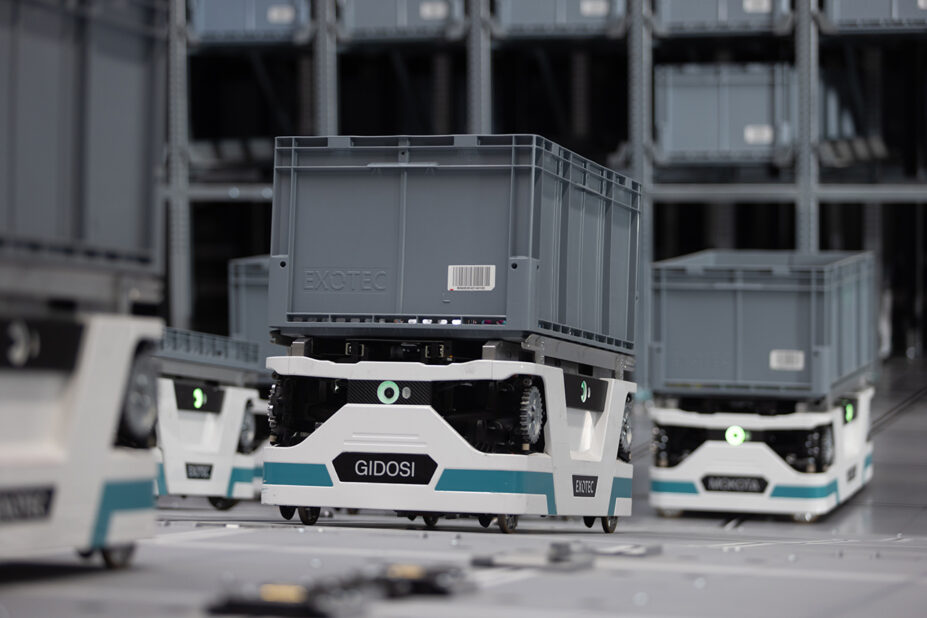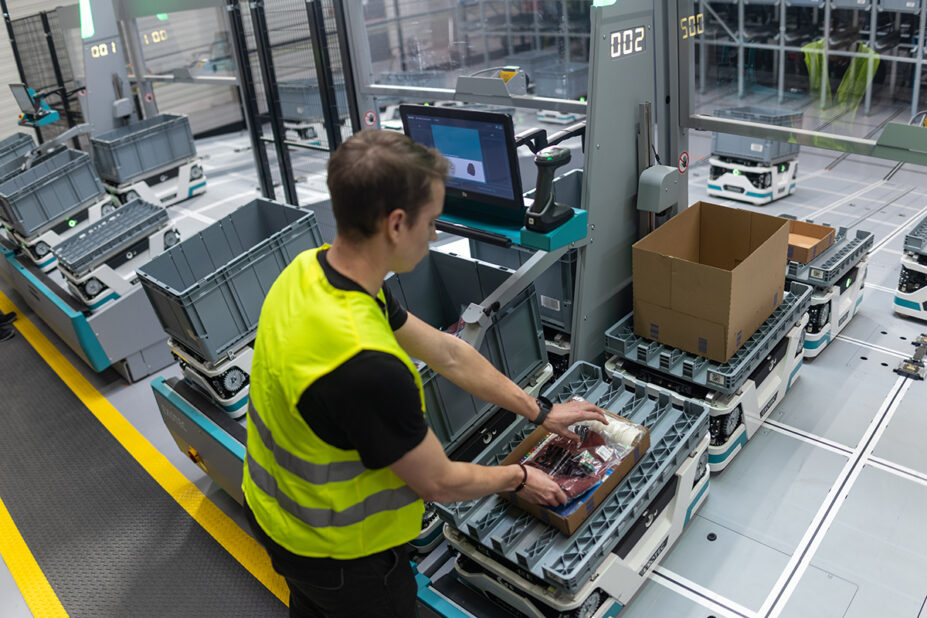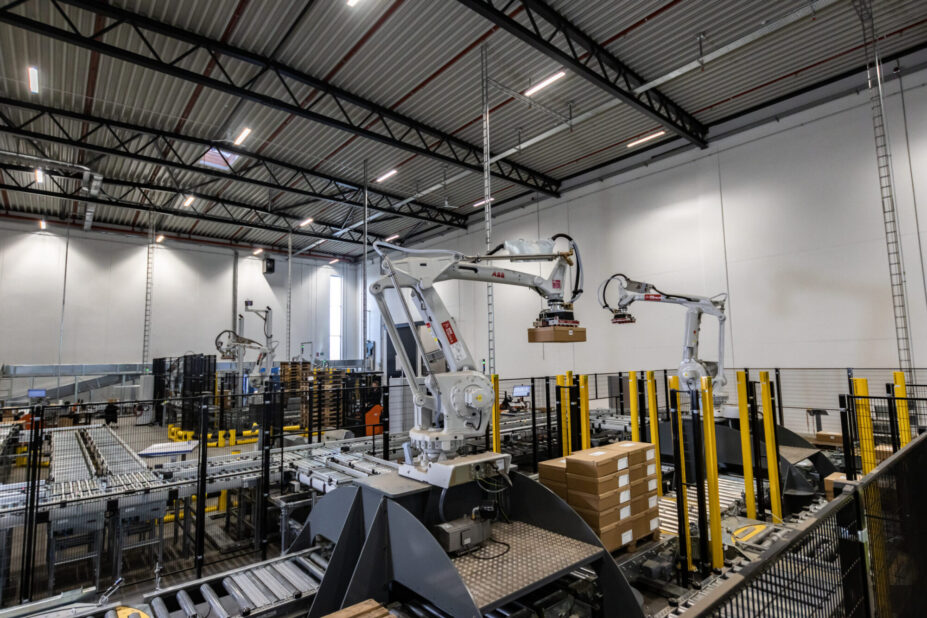Warehousing in 2025 is defined by rapid transformation, as businesses adapt to growing complexity and higher customer expectations. To stay competitive, companies are embracing a new generation of technologies and strategies that go far beyond traditional storage and fulfillment. From the rise of robotic automation and AI-driven analytics to a sharper focus on cybersecurity, sustainability, and operational flexibility, the modern warehouse is evolving into a smart, resilient, and scalable ecosystem. Let’s take a look at the breakthrough trends transforming warehouses in 2025.

Robotic Automation Expansion
In 2025, automation—especially robotics—is transforming the way warehouses operate with technologies like:
- Autonomous Mobile Robots (AMRs): Robots that independently navigate warehouse floors to transport goods between different areas
- Automated Storage & Retrieval Systems (AS/RS): Enclosed systems that use robots and/or machinery to transport goods between storage racks and picking stations
- Robotic Arms: Pick up, move, and place individual items with precision
Robotic automation systems have shifted from nice-to-have to must-have as they provide key benefits to business warehouses, including:
Greater Efficiency, Smarter Resource Allocation
By taking on repetitive and time-consuming tasks like transferring products from storage bins to conveyors—tasks that require little ingenuity—robotic automation frees up human workers to focus on higher-value, strategic roles. The result is continuous operation, faster workflows, a major boost in order throughput, and a more engaged, purpose-driven workforce.
Scalable and Adaptable Operations for an Unpredictable Future
Unlike traditional mechanized automation—often built around bulky, static machinery and rigid PLC-based programming—modern robotic automation systems are designed for flexibility and scalability. They use lighter, modular components and PC-based programming powered by advanced algorithms, making them easier to update both physically and digitally. As a result, these systems can rapidly adapt to shifting demand, support evolving business needs, and continuously improve over time.
Precision, Predictability, and Visibility Across the Workflow
With robotic handling and movement, the guesswork of manual operations is eliminated. Tasks like picking, packing, and inventory tracking become precise and consistent, dramatically reducing errors and minimizing returns. At the same time, these systems provide real-time visibility into product location and status as items move between processes—giving customers and operators greater confidence, control, and insight across the entire fulfillment journey.
Real World Scenario
In today’s fulfillment centers, hiring pickers is harder than ever. The work is physically demanding, with employees often walking more than 10 miles each day in search of ordered items. Add to that a nationwide labor shortage, and it’s clear why warehouses are turning to robotic automation.
Imagine an e-commerce warehouse gearing up for the holidays, expecting a 50% spike in orders. With an AS/RS like the Exotec Skypod® system, they can simply rent and add more robots to keep up—no need to worry about delays or missed deliveries during the busiest time of year. Urgent orders are prioritized automatically, workflows are optimized in real-time, and after the rush, it all scales back just as easily—avoiding disruptions and keeping fulfillment running smoothly when it matters most.

Sustainability and Green Warehousing
In 2025, companies are increasingly adopting green innovations that benefit both the environment and their bottom lines. From renewable energy systems to right-sized packaging automation and energy-efficient robotics, warehouses are reducing waste, lowering emissions, and cutting costs all at once.
Energy-Efficient Warehousing
Warehouse leaders are investing more time and energy into finding smarter ways to save it. Many are turning to Energy Management Systems (EMS)—centralized platforms that track, analyze, and optimize energy use in real time. These systems identify inefficiencies and automate energy-saving actions. They often integrate with HVAC, lighting, and other building systems to make automatic adjustments based on occupancy, time of day, or weather.
Advanced automation technologies, such as AS/RS and AMRs, also contribute by reducing the need for heavy, energy-intensive equipment and minimizing travel distances within the facility. Together, these tools help warehouses lower their carbon footprint while boosting productivity.
Right-Sized Packing
Have you ever ordered something small—like a toothbrush—only to have it arrive in a box big enough for a pair of cowboy boots? You’re not alone. That kind of packaging waste is exactly what many warehouses are working to eliminate. Right-sized packaging automation ensures each order is packed in a box that fits just right. This reduces the use of excess packing materials and, because smaller boxes take up less space, also lowers the number of pallets needed—ultimately requiring fewer trucks for transport and cutting down on emissions.
Space Optimization and Real Estate Savings
Automation systems with tall vertical storage maximize warehouse space, reducing the need for expansions or new facilities. By optimizing the cubic footage of existing warehouses, companies lower construction costs and decrease the environmental impact of new builds. This is especially relevant in urban areas, where real estate is expensive, and land development often clashes with sustainability goals.
Sustainable Transportation and Logistics
By improving inventory accuracy and speeding up order fulfillment, automation helps ensure customers receive the right items on the first try. Fewer picking errors mean fewer returns and re-deliveries, which not only cuts transportation costs but also significantly reduces emissions from extra trips. Additionally, with better inventory visibility, companies can consolidate shipments more efficiently, avoid stockouts or overstocking, and plan smarter delivery routes—further minimizing the environmental impact of their logistics operations.

AI and Predictive Analytics
In 2025, AI and predictive analytics are like crystal balls for supply chain managers, helping them anticipate demand, optimize inventory, and streamline operations. By leveraging vast amounts of data, these technologies empower warehouses to make smarter, faster, and more accurate decisions.
Demand Forecasting
AI-driven predictive analytics enable warehouses to anticipate shifts in customer demand with remarkable accuracy. For instance, algorithms can analyze historical sales data, market trends, and external factors such as the weather to predict which products will see increased demand. This allows warehouses to adjust inventory levels proactively, reducing stockouts and overstock situations.
Inventory Optimization
AI tools are redefining how warehouses manage inventory in an increasingly unpredictable world. SKU performance can change overnight—what was a slow mover yesterday can become a hot seller today thanks to an influencer’s viral post. A company can pivot from mostly B2C to mostly B2B in a matter of weeks.
For manual warehouses, adapting to this kind of volatility is a logistical headache. But in automated environments powered by AI and PC-based robotics, adapting is seamless. These systems track SKU behavior in real time, identify emerging trends, and dynamically reassign product locations to reduce retrieval times and optimize workflows. They can even recommend strategic reallocations or promotions to free up valuable space.
Predictive Maintenance
Downtime can disrupt warehouse operations and incur significant costs, but AI-powered predictive maintenance minimizes this risk. Sensors embedded in automated systems monitor performance metrics such as vibration, temperature, and energy consumption, identifying signs of wear and tear before they lead to breakdowns. By scheduling maintenance proactively, warehouses can avoid unexpected interruptions, extend equipment lifespan, and save on repair costs.
Enhanced Workforce Planning
AI is also helping warehouses optimize labor deployment. Predictive models analyze incoming order volumes, peak seasons, and employee productivity to recommend ideal staffing levels. This ensures that warehouses are neither overstaffed nor under-resourced, leading to better cost control and higher efficiency.
Dynamic Routing and Workflow Optimization
Advanced AI systems integrate with warehouse management systems (WMS) to streamline workflows. For example, AI can dynamically adjust picking routes to prioritize urgent orders or accommodate changing workloads in real time. This reduces unnecessary movement, increases order processing speeds, and enhances efficiency.
AI and predictive analytics give warehouses a strategic advantage by transforming data into actionable insights. These technologies enable warehouses to stay agile in an unpredictable market by improving forecasting, minimizing downtime, and optimizing operations.

Labor and Workforce Solutions
As warehouse operations become increasingly complex, the role of the workforce is evolving. In 2025, the focus is on empowering workers with technology, creating safer environments, and addressing labor shortages through innovative solutions. Integrating robotics and advanced tools is helping warehouses bridge the gap between human capabilities and operational demands. As highlighted by Forbes, robotics plays a role in mitigating labor shortages by automating repetitive and physically demanding tasks, enabling warehouses to maintain productivity and efficiency even amid workforce challenges.
Upskilling the Workforce
Jobs like inventory storage, order picking, and packing—which are highly repetitive and physically demanding—are increasingly being handled by automation systems. This shift frees up workers to focus on tasks that require problem-solving, oversight, and decision-making. As a result, warehouse staff are being upskilled into roles such as system monitoring, quality control, exception handling, and process optimization. This not only helps address labor shortages but also creates more engaging career paths, making warehouse work more attractive and sustainable in the long run.
Safer Work Environments
Automation is also critical to improving workplace safety. Automating repetitive and physically demanding tasks, such as heavy lifting or high-reach picking, reduces the risk of injuries. Collaborative robots (cobots) work alongside employees to handle strenuous tasks, allowing workers to focus on less hazardous activities.
Ergonomic innovations enhance safety. Adjustable workstations and robotic assistance tools minimize strain and fatigue, creating a healthier and more productive workforce.

Flexible and Modular Warehousing
In 2025, flexibility is more important than ever for warehouses. With unpredictable supply chains, seasonal demand spikes, new regulations, and shifting customer expectations, it’s nearly impossible to plan for everything. That’s why businesses are investing in scalable technology and adaptable layouts that let them adjust quickly and stay efficient—without needing major changes.
Scalable Systems That Grow with the Business
Today’s businesses are prioritizing automation solutions that offer flexibility and scalability—especially when it comes to throughput and storage. Rather than overinvesting upfront, companies are turning to modular systems that allow them to expand as they grow. This approach helps control capital expenditures (CapEx) by avoiding the need to purchase more equipment than necessary at the start. As demand increases, they can simply add more equipment such as robots, storage racks, or workstations—building capacity step by step instead of all at once.
Flexibility to Handle a Wide Range of SKUs
With more product variety than ever, warehouses need automation that can handle a diverse mix of SKUs—different shapes, sizes, packaging types, and storage requirements. From oversized boxes to oddly shaped items, systems must be equipped to manage the complexity of modern inventory. The right automation can simplify induction and picking across these variations, reducing errors and keeping fulfillment moving smoothly, even with highly dynamic product catalogs.
Omnichannel-Ready
Even if a company currently serves only one channel, that can change quickly. A B2B distributor might acquire a direct-to-consumer brand or an e-commerce operation could expand into wholesale. That’s why future-proofing is top of mind—businesses want systems that are built to support omnichannel fulfillment from the start. Choosing automation that can flex across channels ensures they’re ready to pivot without needing an entirely new setup.

Warehouse Cybersecurity
As warehouses embrace automation and connected systems, cybersecurity is set to become one of the most critical concerns in 2025. The growing reliance on IoT devices, warehouse management systems (WMS), and robotics introduces multiple potential entry points for cyberattacks, making it imperative for warehouses to defend their operations against increasingly sophisticated threats. As noted in Supply Chain Brain, the frequency of cyberattacks targeting supply chains has surged by 600% in recent years, highlighting the urgency for robust defenses.
The growing use of IoT-enabled devices in warehouses introduces new cybersecurity vulnerabilities. If sensors that monitor inventory and equipment performance operate over unsecured networks, they can become easy targets for hackers. At the same time, warehouse management systems (WMS)—which serve as the operational hub—are at risk of breaches that could expose sensitive data like inventory levels and delivery schedules. If compromised, these systems can bring operations to a standstill.
How Leading Warehouses Are Strengthening Cybersecurity
To defend against growing cyber threats, forward-thinking warehouses are adopting a multi-layered approach to security that includes key measures such as:
- Segment your networks to isolate critical systems like WMS and IoT devices from general business infrastructure, helping to contain potential breaches before they spread.
- Encrypt all communications, especially between IoT sensors and your WMS, to prevent sensitive data from being intercepted or tampered with.
- Schedule regular security audits to uncover and address vulnerabilities across your hardware, software, and access controls before attackers exploit them.
- Use firewalls and intrusion detection systems (IDS) to proactively monitor network activity and block suspicious behavior before it leads to a breach.
- Apply role-based access controls (RBAC) to ensure employees only have access to the systems and data they need—minimizing the impact of human error or insider threats.
- Educate employees on cybersecurity best practices, such as recognizing phishing attempts, using strong passwords, and securely handling data, to strengthen your first line of defense.
- Develop a clear incident response plan to ensure your team can act quickly and effectively if a breach occurs—reducing recovery time and business disruption.
- Keep all systems and software up to date with the latest patches to close security gaps and protect against known vulnerabilities.

Optimizing Truck Deliveries with Smarter Automation
Businesses are increasingly turning to warehouse automation not just to improve internal operations, but also to boost efficiency on the road. By integrating smart automation strategies, they’re able to reduce the number of trucks needed while ensuring faster, more accurate deliveries.
One major improvement comes from right-sized packaging, where automated systems select the optimal box size for each order. This minimizes wasted space, allowing more items to fit per pallet and more pallets per truck—reducing the total number of trips required.
Automation also enables intelligent pallet sequencing, where items are packed in the exact order they’ll be unloaded at each destination. This streamlines delivery routes, reduces unloading time, and minimizes the need for drivers to rearrange freight on the road.
In addition, automated systems can consolidate orders more effectively, grouping shipments by route, customer, or delivery window to maximize truck utilization. These improvements not only cut transportation costs but also support sustainability efforts by lowering fuel consumption and emissions.
As last-mile expectations continue to rise, warehouse automation plays a key role in helping businesses stay efficient from dock to doorstep.
Shaping the Warehouse of Tomorrow with Exotec
Warehousing in 2025 is evolving into a dynamic, tech-driven ecosystem where robotic automation, AI, sustainability, and cybersecurity converge to meet rising expectations and unpredictable demand. Businesses that embrace flexible, data-informed systems and invest in future-ready solutions will be best positioned to stay competitive, resilient, and efficient—today and in the years to come.
A key part of that evolution is simplifying complexity. Instead of cobbling together multiple solutions, businesses are prioritizing automation systems that can handle several workflows in one. The Exotec Skypod system is a standout example—it supports picking, packing, buffering, sorting, and sequencing within a single AS/RS solution. This all-in-one capability reduces complexity, saves space, and streamlines operations, making it easier to adapt to new demands without layering on more equipment or processes.
Featured In
Share
Insights
-
April 9, 2025Material Handling: Basics, Benefits, & Automation
-
April 4, 2025Complete Guide to Pick-and-Place Automation
-
February 20, 2025What Is 3PL? Understanding the Role of Third-Party Logistics
News
-
April 16, 2025Exotec achieves SOC2 Type 2 Compliance, just months after obtaining ISO/IEC 27001:2022 Cybersecurity Certification
-
March 24, 2025Exotec Showcases Next-Gen Skypod System at ProMat 2025
-
March 17, 2025Exotec Announces Partnership with Oxford Industries to Implement Next Generation Skypod System in New Multi-Brand Distribution Center
Events
-
May 7, 2025Exodinner: Indianapolis, IN
-
May 22, 2025 | Cincinnati, OHExotour: Cincinnati, OH
-
May 28, 2025Exodinner: Vancouver, BC